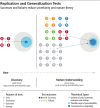What is replication?
- PMID: 32218571
- PMCID: PMC7100931
- DOI: 10.1371/journal.pbio.3000691
What is replication?
Abstract
Credibility of scientific claims is established with evidence for their replicability using new data. According to common understanding, replication is repeating a study's procedure and observing whether the prior finding recurs. This definition is intuitive, easy to apply, and incorrect. We propose that replication is a study for which any outcome would be considered diagnostic evidence about a claim from prior research. This definition reduces emphasis on operational characteristics of the study and increases emphasis on the interpretation of possible outcomes. The purpose of replication is to advance theory by confronting existing understanding with new evidence. Ironically, the value of replication may be strongest when existing understanding is weakest. Successful replication provides evidence of generalizability across the conditions that inevitably differ from the original study; Unsuccessful replication indicates that the reliability of the finding may be more constrained than recognized previously. Defining replication as a confrontation of current theoretical expectations clarifies its important, exciting, and generative role in scientific progress.
Conflict of interest statement
We have read the journal’s policy and the authors of this manuscript have the following competing interests: BAN and TME are employees of the Center for Open Science, a nonprofit technology and culture change organization with a mission to increase openness, integrity, and reproducibility of research.
Figures


References
-
- Schmidt S. Shall we really do it again? The powerful concept of replication is neglected in the social sciences. Rev Gen Psychol. 2009;13(2): 90–100. 10.1037/a0015108 - DOI
Publication types
MeSH terms
LinkOut - more resources
Full Text Sources

